Energy Evolution Law of Sandstone Material during Post-Peak Cyclic Loading and Unloading under Hydraulic Coupling
Abstract
:1. Introduction
2. Test Method
3. Analysis of Rock Energy Evolution Law
3.1. Energy Calculation Method
3.2. Stress–Strain Curves for the Entire Process
- (1)
- Under varying levels of confining pressure, the stress–strain curves of the specimens exhibit a similar overall pattern. The peak stress is observed during the loading phase as the axial displacement increases. Subsequently, the axial stress is unloaded by reducing the axial displacement, returning to the same value as the confining pressure, thus completing one loading and unloading cycle. The axial stress is then reloaded through further displacement. During the loading phase, the specimen does not reach a residual stage, and the axial stress still exhibits a peak, albeit at a lower magnitude compared to the previous peak. As the axial displacement increases in the final loading process, the axial stress mostly remains constant, indicating that the specimen has entered the residual stage.
- (2)
- Before reaching the residual stage, the specimen experiences an increase in axial stress and axial strain during each loading cycle. Conversely, the axial strain of the specimen decreases during the unloading process. Notably, at the first cycle, the axial strain resulting from the peak stress of the specimen exceeds the axial strain caused during subsequent cycles when the axial stress reaches the peak stress of the cycle.
- (3)
- During each cycle of loading and unloading, the unloading curve of the specimen is positioned below the loading curve, forming a concave and convex curve, respectively. The endpoint of the unloading curve cannot coincide with the starting point of the loading curve after unloading to the triaxial isobaric state, resulting in the formation of a hysteresis loop between the two [30]. The area of the hysteresis loop can be characterized as the energy dissipated for the internal damage and plastic deformation of the rock. Additionally, a negative correlation exists between the hysteresis loop’s area and the number of cycles.
- (4)
- From Figure 5 and Figure 7e,f, it is clear that the specimen experiences a direct transition from axial stress to zero without exhibiting a residual stage during the final stage of the test. This phenomenon can be attributed to the increasing damage level of the rock as the test progresses. As the test progresses, the internal cracks within the rock gradually propagate and multiply. Simultaneously, the pore pressure reaches a high level, which leads to the complete damage of the rock and the loss of its load-bearing capacity.
3.3. Post-Peak Cyclic Loading and Unloading Energy Evolution Curves
3.4. Post-Peak Cyclic Loading and Unloading Energy Rate of Change Curves
4. Analysis of Failure Characteristics of Sandstone Specimens
5. Conclusions
- (1)
- The elastic energy density of the specimen decreases as the number of cycles (axial strain) increases. This implies that with each subsequent cycle of loading and unloading, the specimen exhibits a decrease in its elastic energy storage capacity. Furthermore, the total input energy density and dissipation energy density of the specimen follow a similar trend. As the number of cycles (axial strain) increases, both the total input energy density and the dissipation energy density decrease. However, it is noted that after a certain point, both energy densities tend to stabilize.
- (2)
- With the increase in confining pressure, the maximum and residual elastic energy densities of the rock increase gradually. Confining pressure inhibits the release of elastic energy.
- (3)
- The maximum dissipated energy density of the rock is positively correlated with confining pressure. As the confining pressure increases, the rate of increase in the maximum dissipated energy density gradually decreases. This suggests that confining pressure can inhibit the dissipation and release of rock energy.
- (4)
- Pore pressure can destroy the bearing structure of the rock and reduce the energy storage capacity of the rock. In situations where the confining pressure remains constant and the specimen undergoes the same number of cycles, there exists a negative correlation between pore pressure and the specimen’s total input energy density, elastic energy density, and dissipation energy density.
- (5)
- With the increase in the number of cycles (axial strain), the proportion of elastic energy initially rises and then declines, while the proportion of dissipated energy follows the opposite trend. Additionally, an increase in confining pressure can lead to a higher peak value of the proportion of elastic energy and promote energy accumulation after rock failure.
Author Contributions
Funding
Institutional Review Board Statement
Data Availability Statement
Conflicts of Interest
References
- Zhao, Y.; Liu, J.; Zhang, C.; Zhang, H.; Liao, J.; Zhu, S.; Zhang, L. Mechanical behavior of sandstone during post-peak cyclic loading and unloading under hydromechanical coupling. Int. J. Min. Sci. Technol. 2023, 33, 927–947. [Google Scholar] [CrossRef]
- Dai, S.; Gong, Y.; Wang, F.; Hu, P. Experimental Study on Influential Factors of Shale Permeability Based on the Gas Pulse Decay Method. Fresenius Environ. Bull. 2019, 28, 6307–6313. [Google Scholar]
- Xu, J.; Yang, H.; Li, S.; Jiang, Y. Experimental study of effects of cyclic loading and unloading pore water pressures on deformation characteristic of sandstone. Chin. J. Rock Mech. Eng. 2009, 28, 892–899. [Google Scholar]
- Yang, H.; Xu, J.; Nie, W.; Peng, S. Experimental study on creep of rocks under step loading of seepage pressure. Chin. J. Geotech. Eng. 2015, 37, 1613–1619. [Google Scholar]
- Liu, Y.; Li, X.; Tu, Y.; Lu, Y. Mining Leachates Effect on the Hydraulic Performance of Geosynthetic Clay Liners under Different Temperatures. Water 2023, 15, 1132. [Google Scholar] [CrossRef]
- Pan, Y.-H.; Qi, J.-R.; Zhang, J.-F.; Peng, Y.-X.; Chen, C.; Ma, H.-N.; Ye, C. A comparative study on steady-state water inflow into a circular underwater tunnel with an excavation damage zone. Water 2022, 14, 3154. [Google Scholar] [CrossRef]
- Xue, T.; Xue, X.; Long, S.; Chen, Q.; Lu, S.; Zeng, C. Effect of Pre-Existing Underground Structures on Groundwater Flow and Strata Movement Induced by Dewatering and Excavation. Water 2023, 15, 814. [Google Scholar] [CrossRef]
- Li, T.; Chen, Z.; Chen, G.; Ma, C.; Tang, O.; Wang, M. An experimental study of energy mechanism of sandstone with different moisture contents. Rock Soil Mech. 2015, 36, 229–236. [Google Scholar]
- Peng, Y.; Liu, G.; Wu, L.; Zuo, Q.; Liu, Y.; Zhang, C. Comparative study on tunnel blast-induced vibration for the underground cavern group. Environ. Earth Sci. 2021, 80, 68. [Google Scholar] [CrossRef]
- Zhang, J.; Yang, F.; Zhang, R.; He, J.; Xie, Y.; Miao, Z.; Zhang, J. Experimental Research on Coal Seam Structure and Gas Occurrence Influencing Factors in Weijiadi Mine China. Fresenius Environ. Bull. 2022, 31, 74–80. [Google Scholar]
- Zhang, Z.; Gao, F. Confining pressure effect on rock energy. Chin. J. Rock Mech. Eng. 2015, 34, 1–11. [Google Scholar]
- Liu, X.-X.; Li, Y.; Fan, Z.-J.; Li, S.-N.; Wang, W.-W.; Dong, P. Energy evolution and failure characteristics of single fissure carbonaceous shale under drying−wetting cycles. Rock Soil Mech. 2022, 43, 1. [Google Scholar]
- Chen, Z.; He, C.; Wu, D.; Gan, L.; Xu, G.; Yang, W. Mechanical properties and energy damage evolution mechanism of deep-buried carbonaceous phyllite. Rock Soil Mech. 2018, 39, 445–456. [Google Scholar]
- Qin, T.; Duan, Y.; Sun, H.; Wang, L.; Liu, H. Mechanical characteristics and energy dissipation characteristics of sandstone under triaxial stress conditions. J. China Coal Soc. 2020, 45, 255–262. [Google Scholar]
- Liu, G.; Li, Y.; Xiao, F.; Huang, S.; Zhang, R. Study on failure mechanics behavior and damage evolution law of yellow sandstone under uniaxial triaxial and pore water action. Chin. J. Rock Mech. Eng. 2019, 38, 3532–3544. [Google Scholar]
- Zhao, Y.; Tan, T.; Zhang, C.; Liu, Q.; Zhang, Y.; Wu, L.H. Mechanical properties and energy evolution and the applicability of strength criteria of sandstone under hydro-mechanical coupling. J. China Coal Soc. 2023, 48, 3323–3335. [Google Scholar]
- Liu, H.; Yang, X. Mechanical properties and energy evolution law behind sandstone under triaxial cyclic loading. J. Heilongjiang Univ. Sci. Technol. 2023, 33, 18–23+39. [Google Scholar]
- Meng, Q.; Wang, C.; Huang, B.; Pu, H.; Zhang, Z.; Sun, W.; Wang, J. Rock energy evolution and distribution law under triaxial cyclic loading and unloading conditions. Chin. J. Rock Mech. Eng. 2020, 39, 2047–2059. [Google Scholar]
- Yang, X.; Cheng, H.; Pei, Y. Study on the evolution characteristics of rock deformation and post-peak energy under different loading methods. Chin. J. Rock Mech. Eng. 2020, 39, 3229–3236. [Google Scholar]
- Lu, X.; Xu, J.; Ge, H.; Zhao, D.; Bai, E. Effects of confining pressure on mechanical behaviors of sandstone under dynamic impact loads. Chin. J. Rock Mech. Eng. 2010, 29, 193–201. [Google Scholar]
- Jing, W.; Xue, W.; Yao, Z. Variation of the internal friction angle and cohesion of the plastic softening zone rock in roadway surrounding rock. China Coal. Soc. 2018, 43, 2203–2210. [Google Scholar]
- Dai, S.; Gong, Y.; Wang, F.; Hu, P. Diagenesis evolution of tight sandstones in Chang 8 Member of Upper Triassic in the Xiasiwan area, Ordos Basin, China. Fresenius Environ. Bull. 2019, 28, 6275–6281. [Google Scholar]
- Yu, W.; Li, K.; Liu, Z.; An, B.; Wang, P.; Wu, H. Mechanical characteristics and deformation control of surrounding rock in weakly cemented siltstone. Environ. Earth Sci. 2021, 80, 337. [Google Scholar] [CrossRef]
- GB/T 23561.1-2009; Methods for Determining the Physical and Mechanical Properties of Coal and Rock—Part 1: General Requirements for Sampling. Chinese Standard: Beijing, China, 2009.
- Xie, H.; Peng, R.; Ju, Y. Energy dissipation of rock deformation and fracture. Chin. J. Rock Mech. Eng. 2004, 23, 3565–3570. [Google Scholar]
- Xie, H.-P.; Ju, Y.; Li, L.-Y. Criteria for strength and structural failure of rocks based on energy dissipation and energy release principles. Chin. J. Rock Mech. Eng. 2005, 24, 3003–3010. [Google Scholar]
- Dai, S.; Wang, F.; Gong, Y.; Hu, P. Application of Material Balance Equation in Productivity Analysis of Coalbed Methane Reservoir. Fresenius Environ. Bull. 2019, 28, 5605–5611. [Google Scholar]
- Xie, H.-P.; Peng, R.-D.; Ju, Y.; Zhou, H.-W. Energy analysis of rock failure. Chin. J. Rock Mech. Eng. 2005, 24, 2603–2608. [Google Scholar]
- Zhang, H.; He, Y.; Tang, C.; Ahmad, B.; Han, L. Application of an improved flow-stress-damage model to the criticality assessment of water inrush in a mine: A case study. Rock Mech. Rock Eng. 2009, 42, 911–930. [Google Scholar] [CrossRef]
- Xiao, F.-k.; Shen, Z.-L.; Liu, G.; Zhang, Z.; Zhang, F. Relationship between hysteresis loop and elastoplastic strain energy during cyclic loading and unloading. Chin. J. Rock Mech. Eng. 2014, 33, 1791–1797. [Google Scholar]
- Can, X.; Shu-chen, L.; Yang, P.; Jing-long, L.; Shu-cai, L. Study of nonlinear damage characteristics and numerical simulation of post-peak fractured rock mass. Rock Soil Mech. 2017, 38, 2128–2136. [Google Scholar]
- Hamiel, Y.; Lyakhovsky, V.; Agnon, A. Rock dilation, nonlinear deformation, and pore pressure change under shear. Earth Planet. Sci. Lett. 2005, 237, 577–589. [Google Scholar] [CrossRef]
- Zhou, H.; Wang, Z.; Ren, W.; Liu, Z.; Liu, J. Acoustic emission based mechanical behaviors of Beishan granite under conventional triaxial compression and hydro-mechanical coupling tests. Int. J. Rock Mech. Min. Sci. 2019, 123, 104125. [Google Scholar] [CrossRef]
- Yang, D.; Hu, J.; Qin, Y. Hydro-mechanical coupling of granite with micro-defects: Insights into underground energy storage. Alex. Eng. J. 2022, 61, 7213–7220. [Google Scholar] [CrossRef]
- Li, F.; You, S.; Ji, H.-g.; Elmo, D.; Wang, H.-t. Strength and energy exchange of deep sandstone under high hydraulic conditions. J. Cent. South Univ. 2020, 27, 3053–3062. [Google Scholar] [CrossRef]
- Ma, J.; Chen, J.; Chen, W.; Huang, L. A coupled thermal-elastic-plastic-damage model for concrete subjected to dynamic loading. Int. J. Plast. 2022, 153, 103279. [Google Scholar] [CrossRef]
- Ma, J.; Zhao, J.; Lin, Y.; Liang, J.; Chen, J.; Chen, W.; Huang, L. Study on Tamped Spherical Detonation-Induced Dynamic Responses of Rock and PMMA Through Mini-chemical Explosion Tests and a Four-Dimensional Lattice Spring Model. Rock Mech. Rock Eng. 2023, 56, 7357–7375. [Google Scholar] [CrossRef]
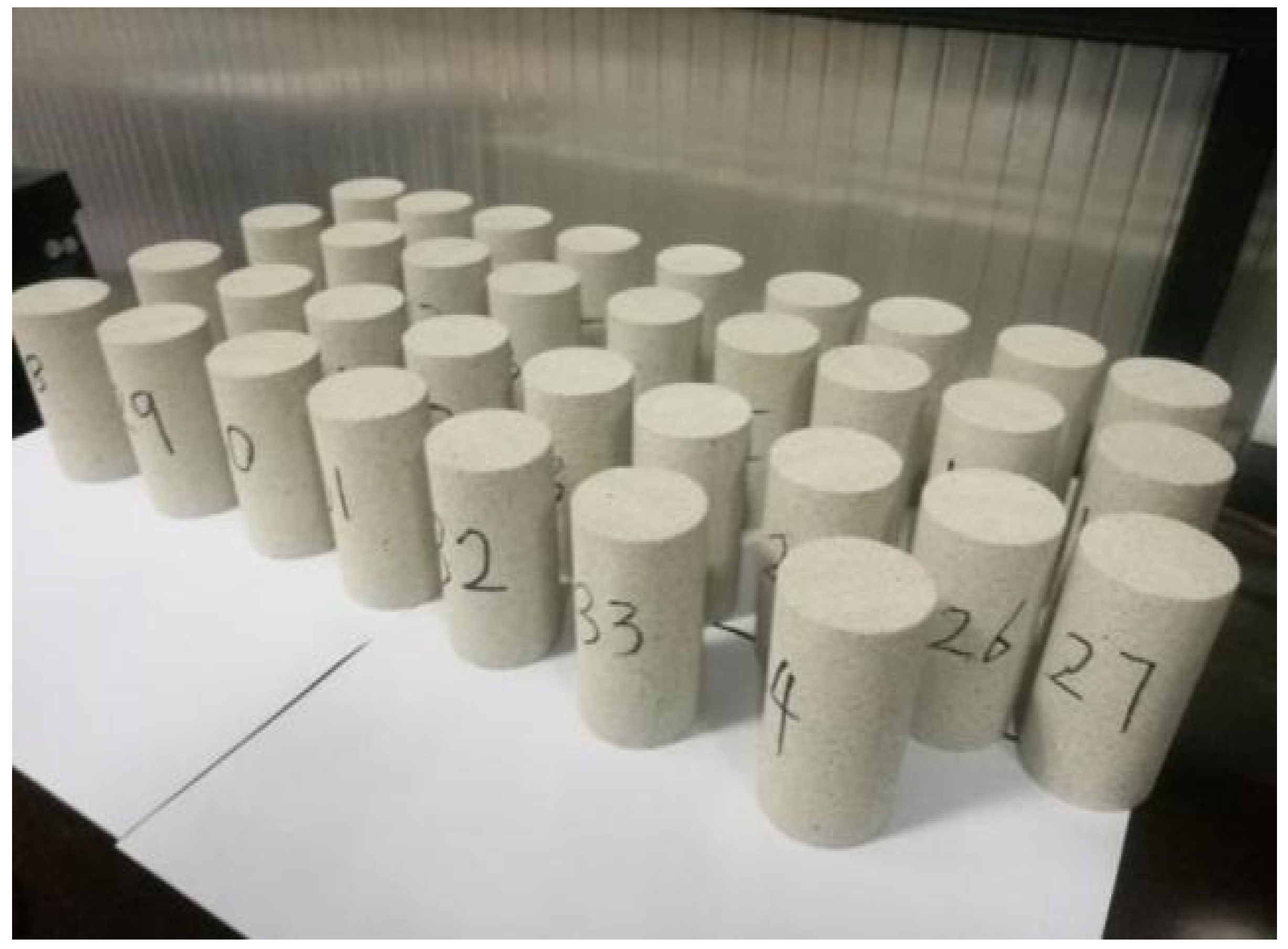

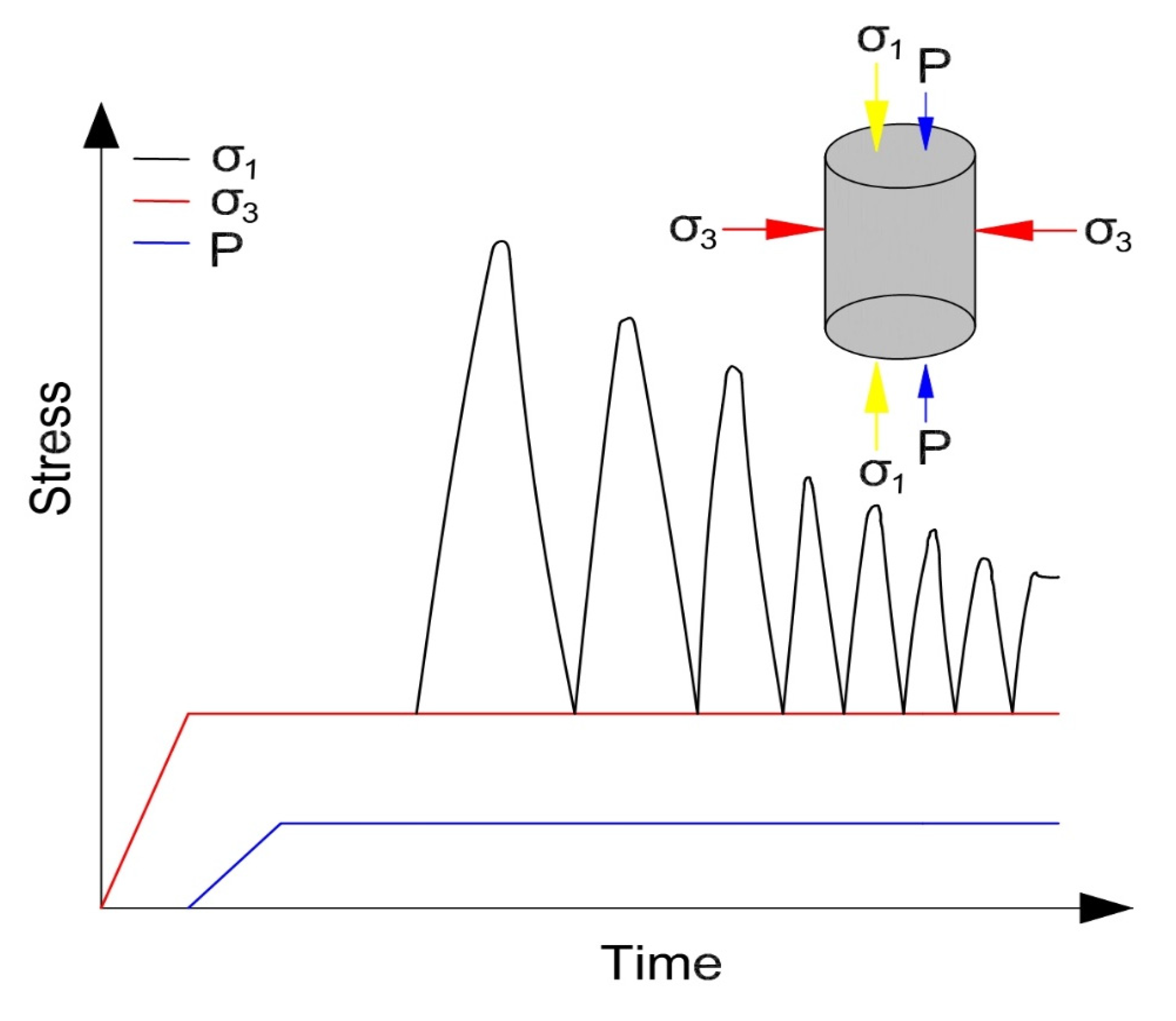
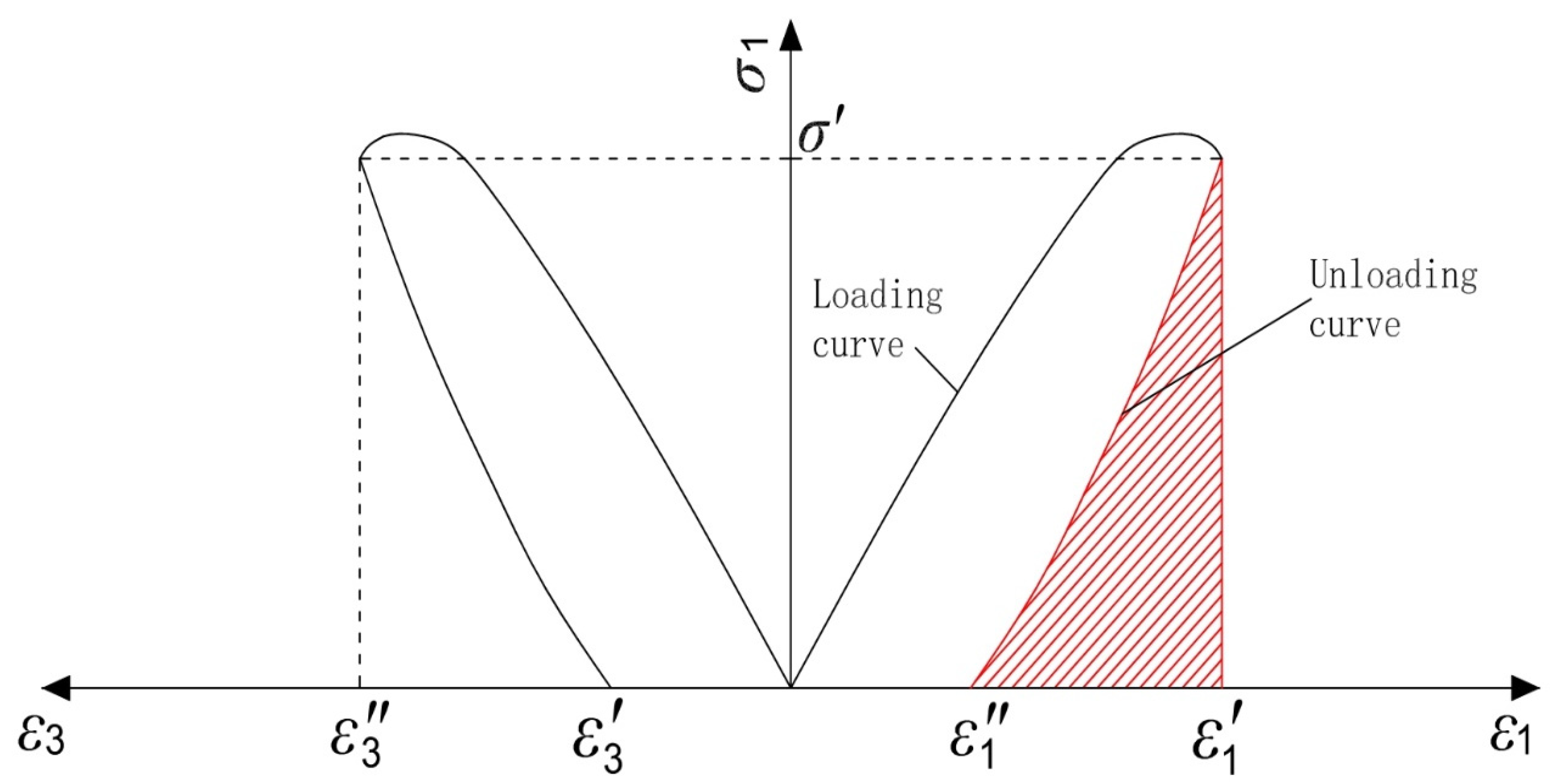




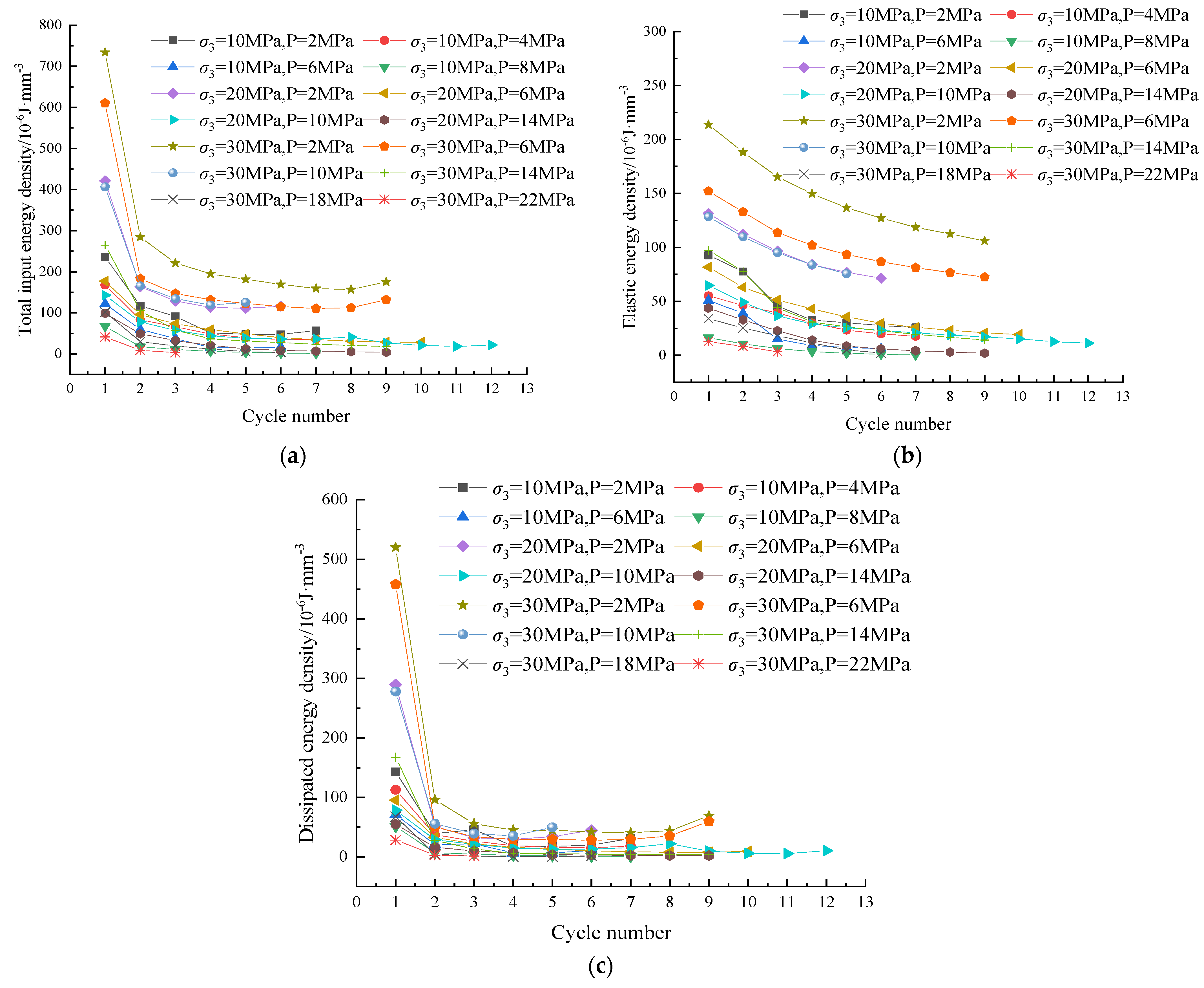
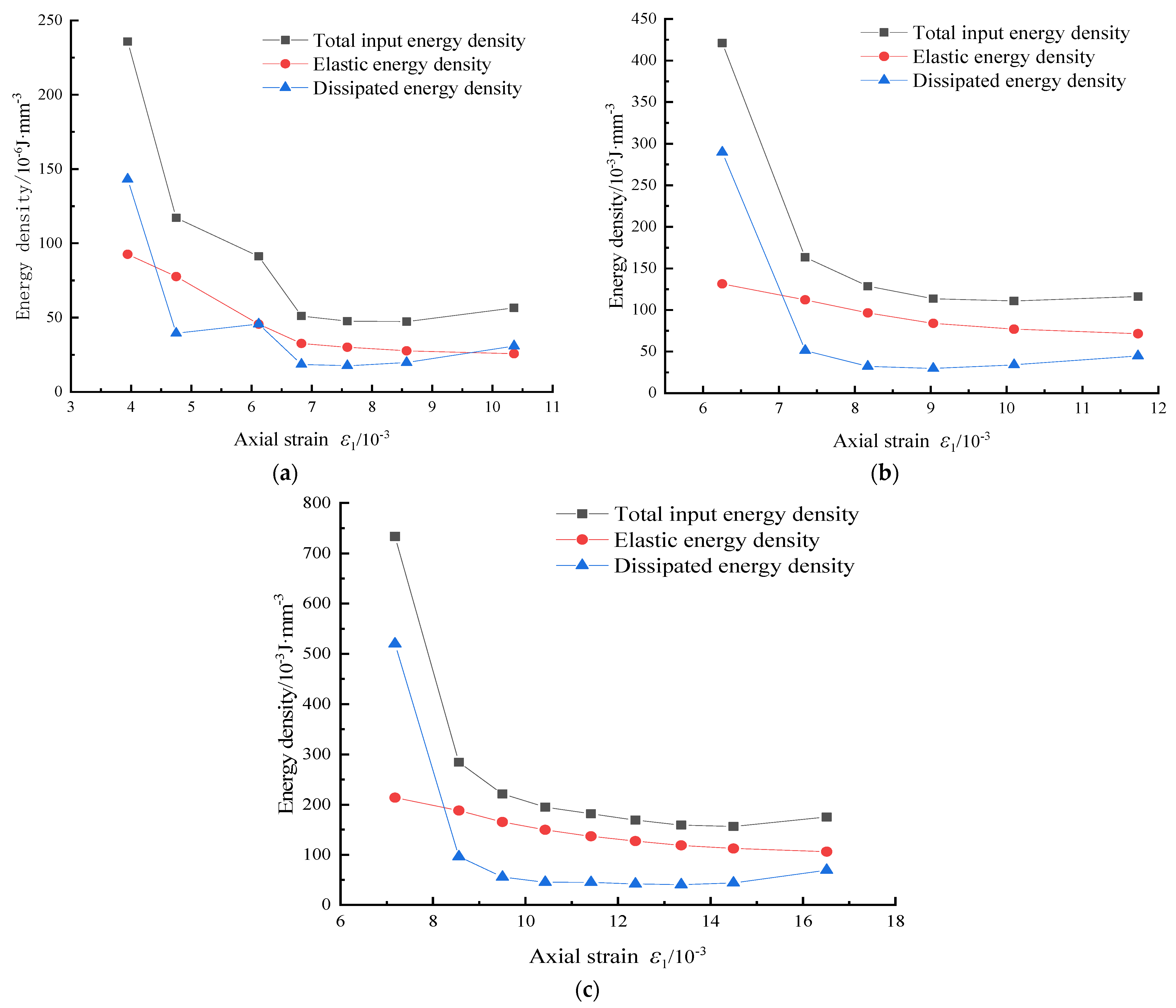
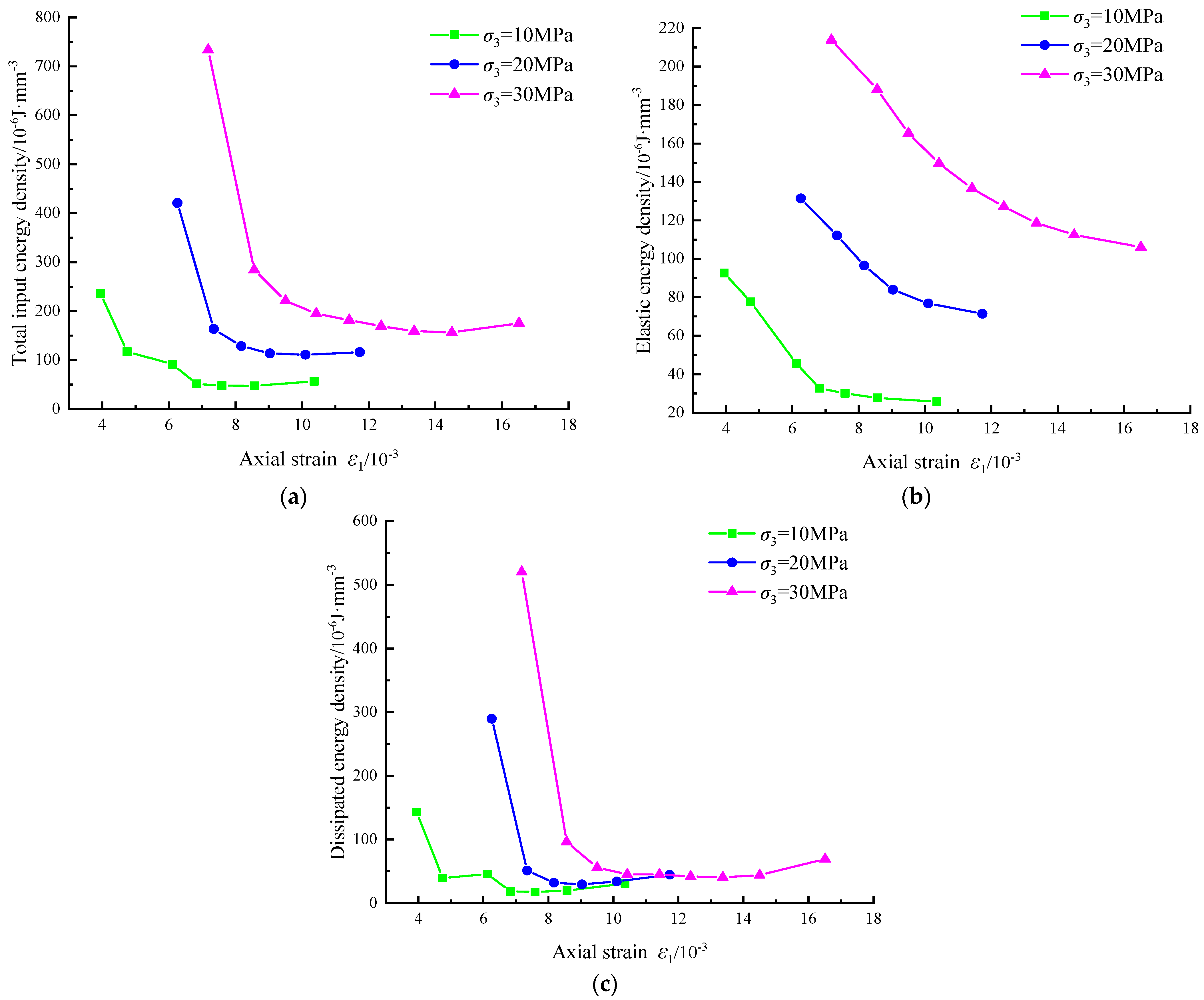
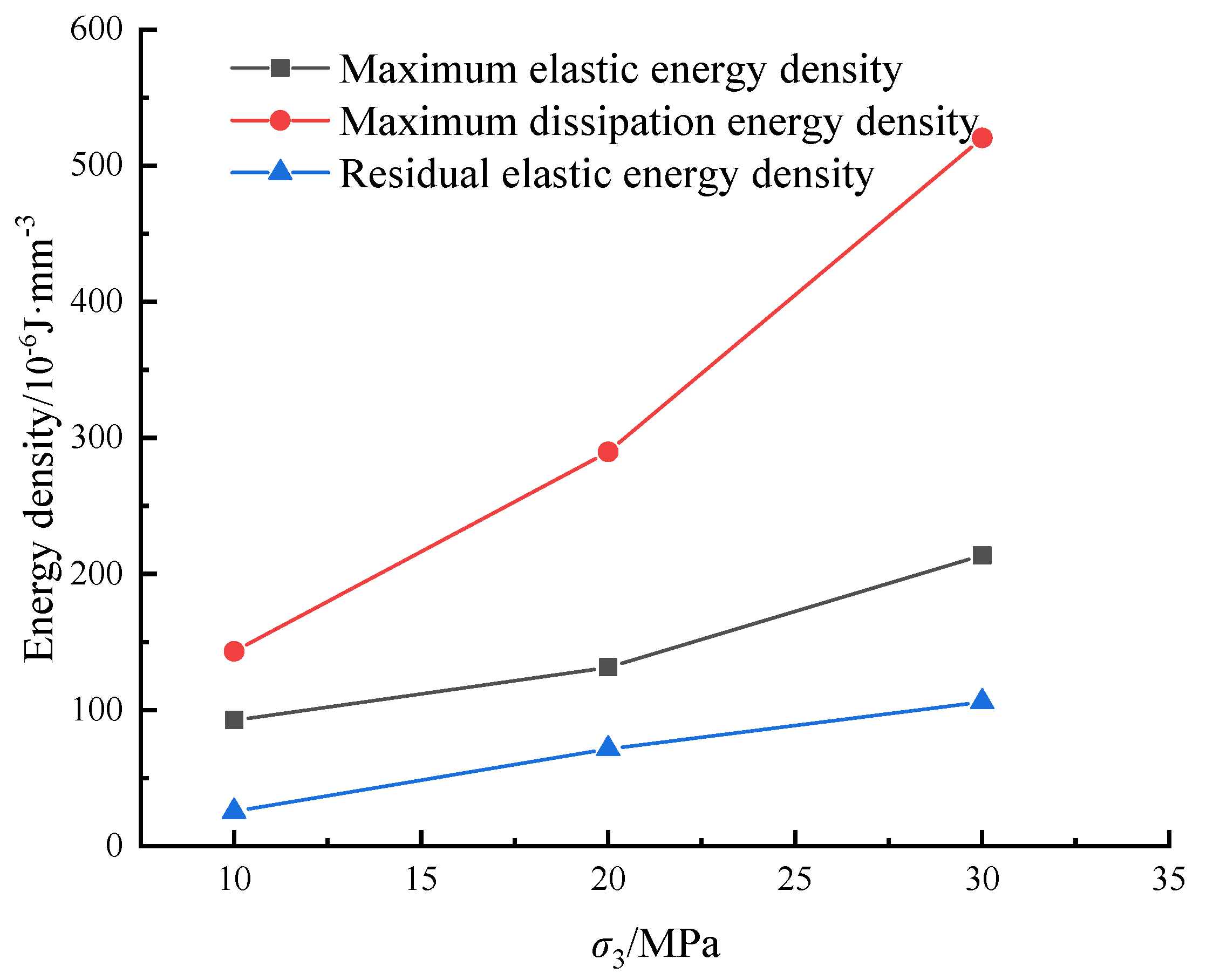
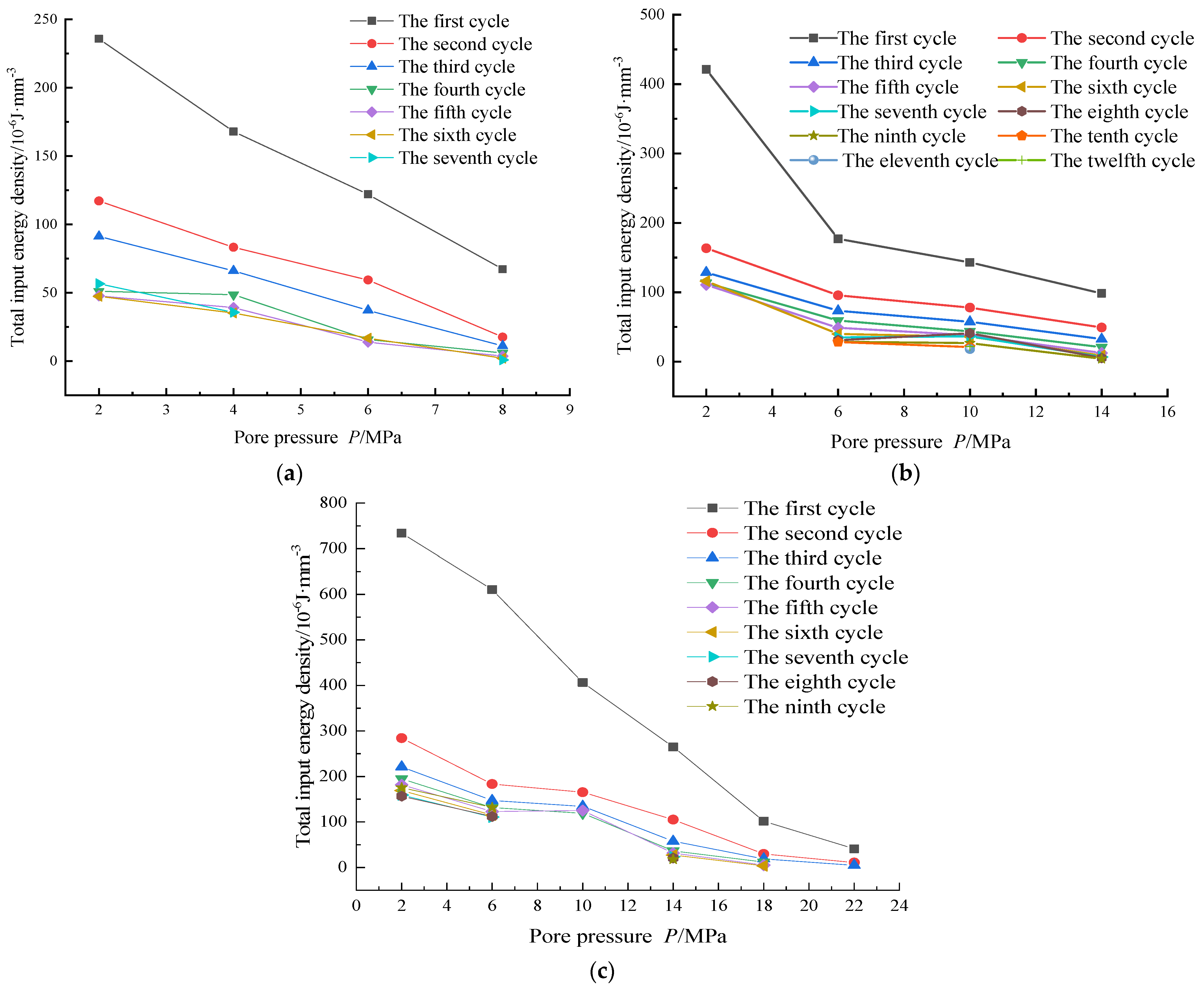
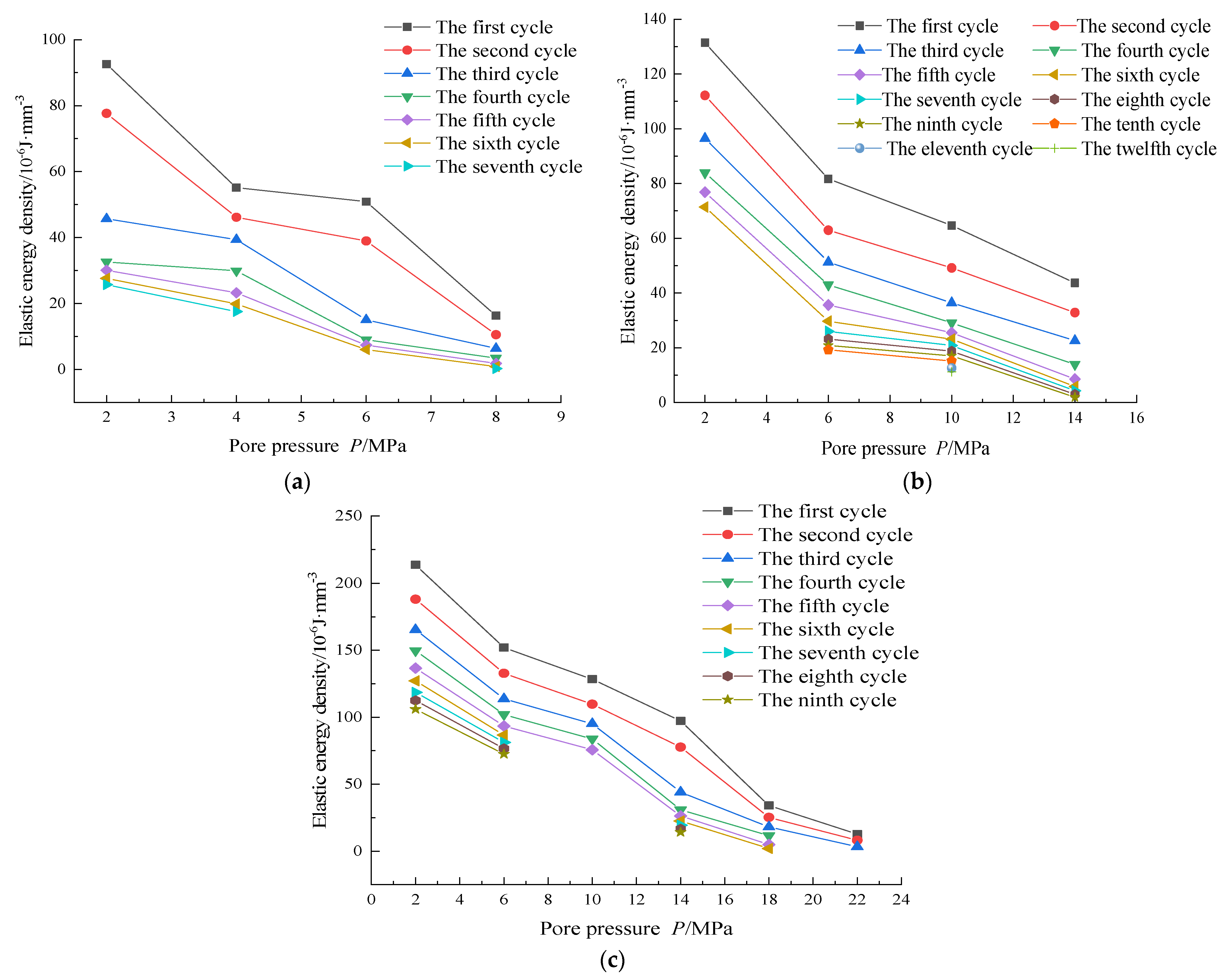
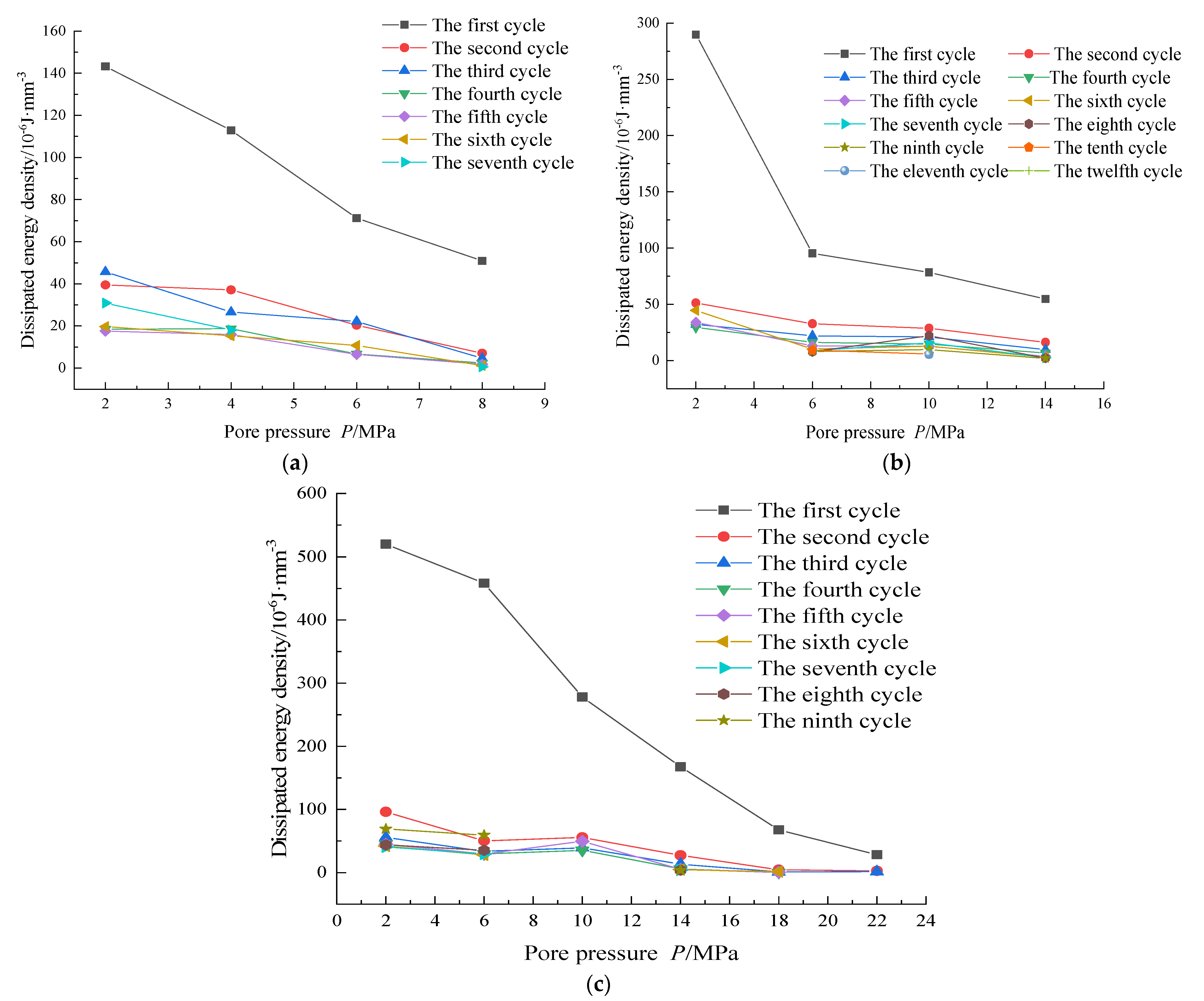
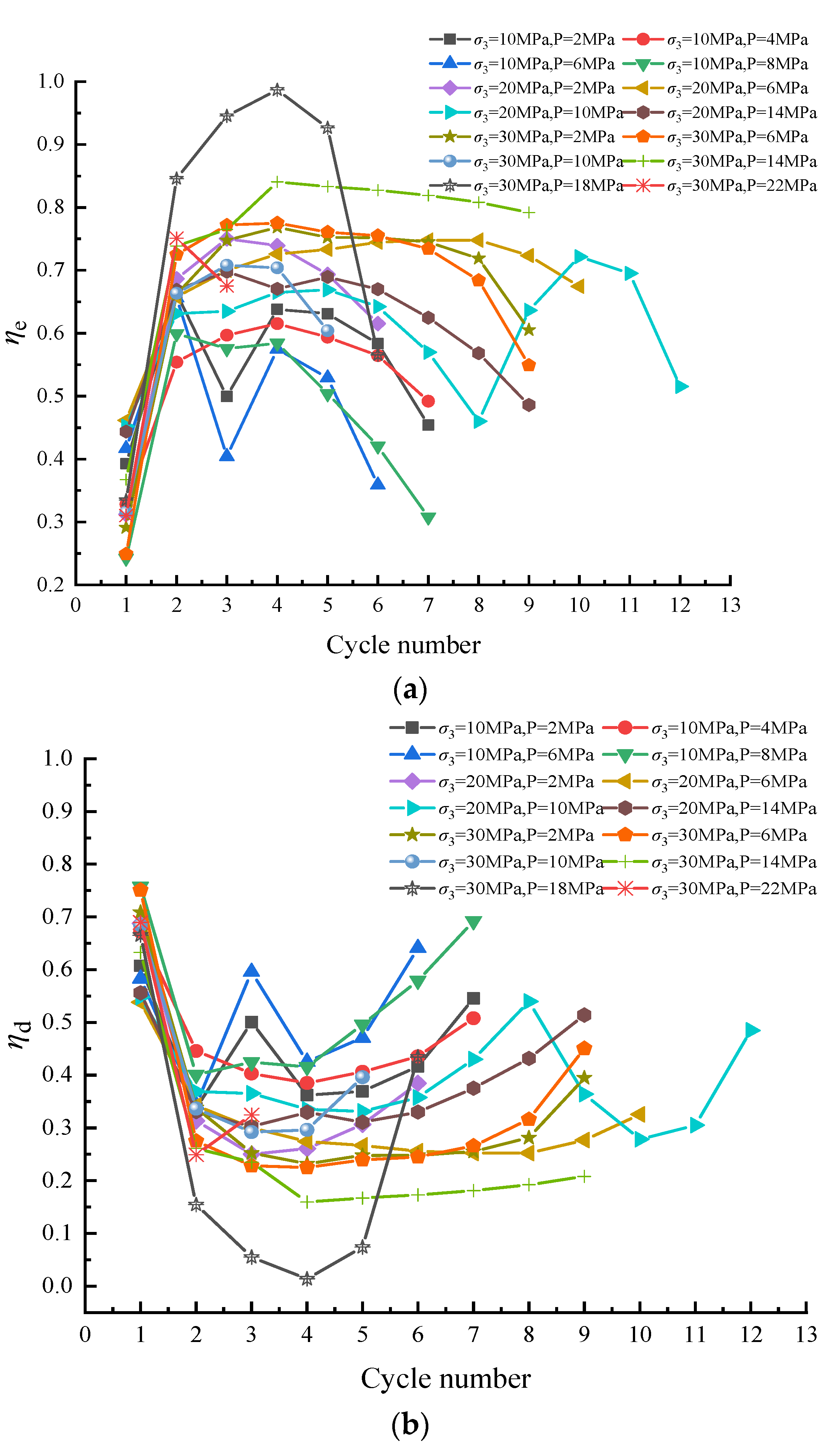
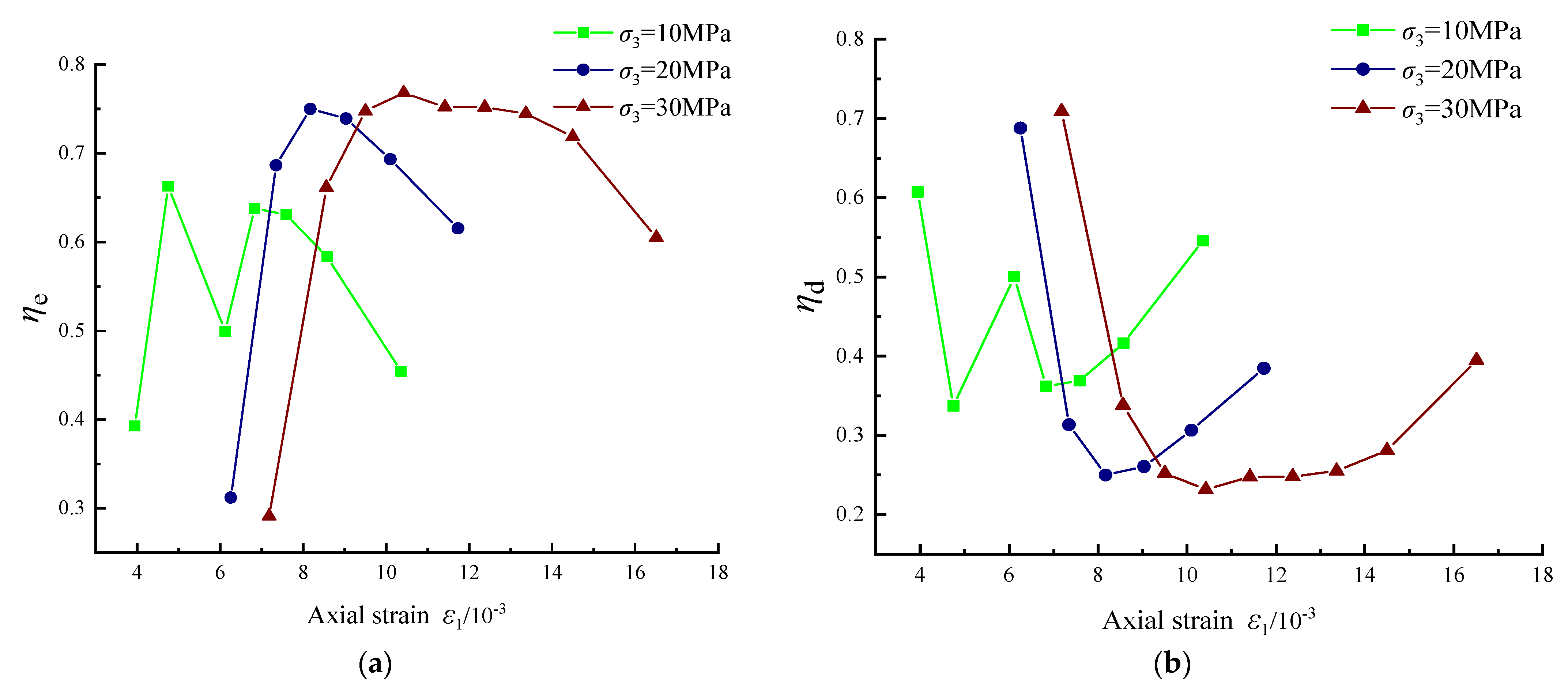
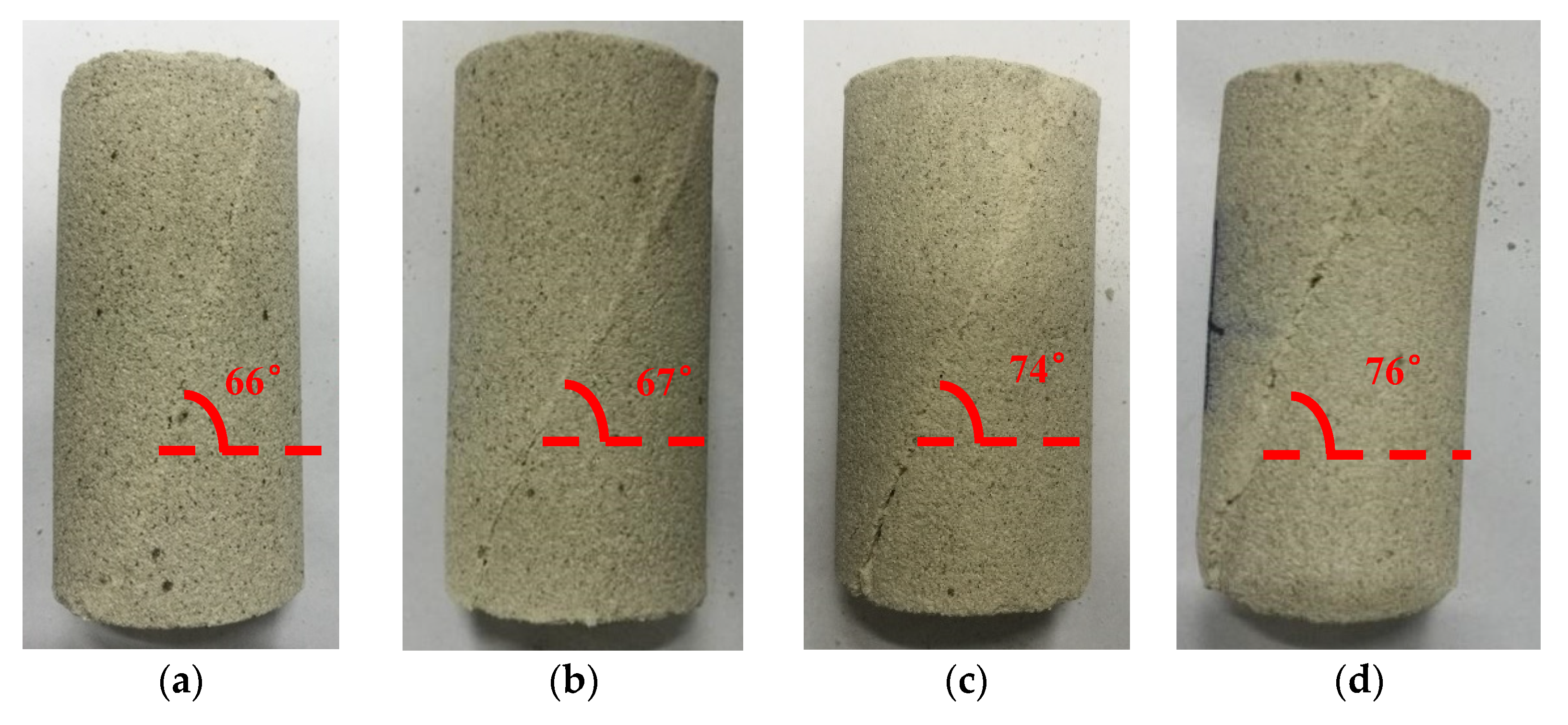
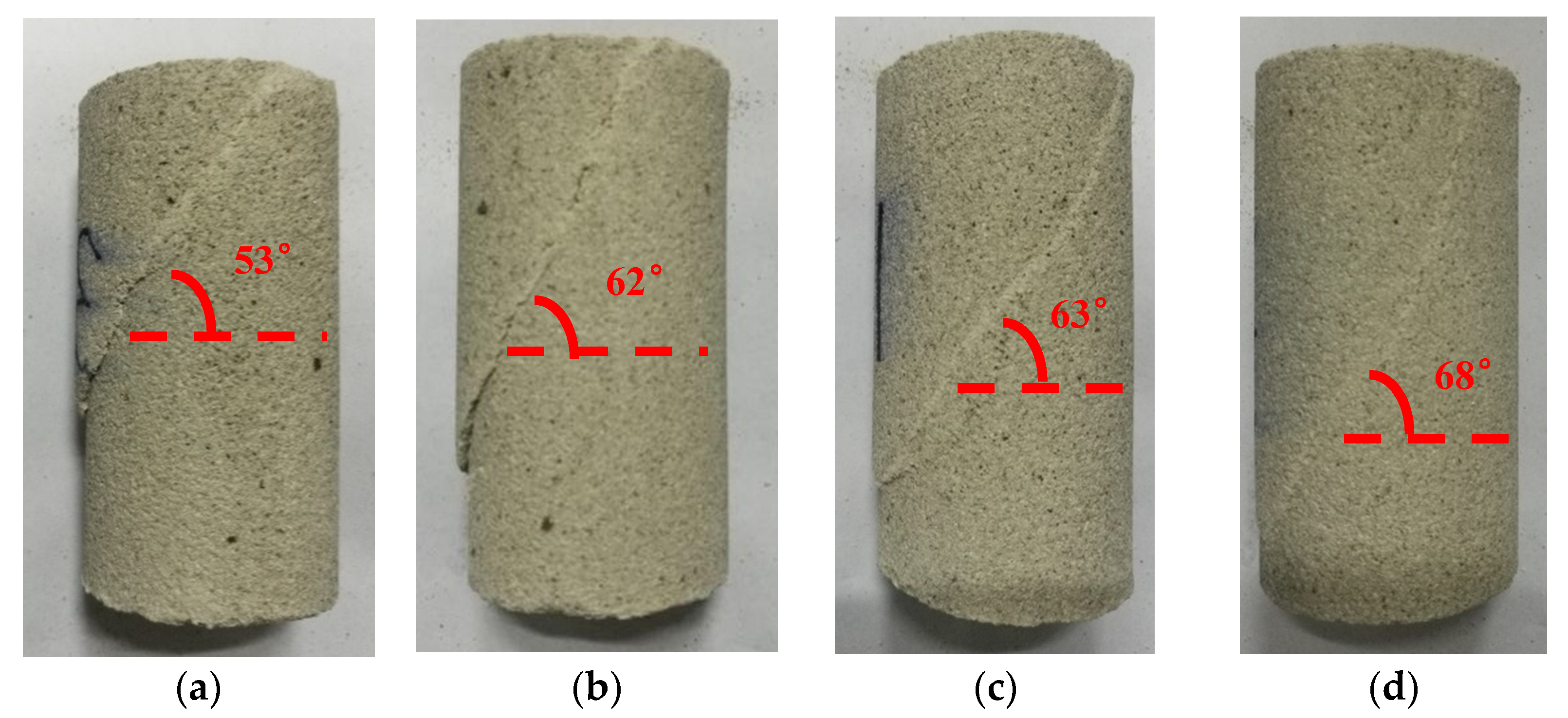
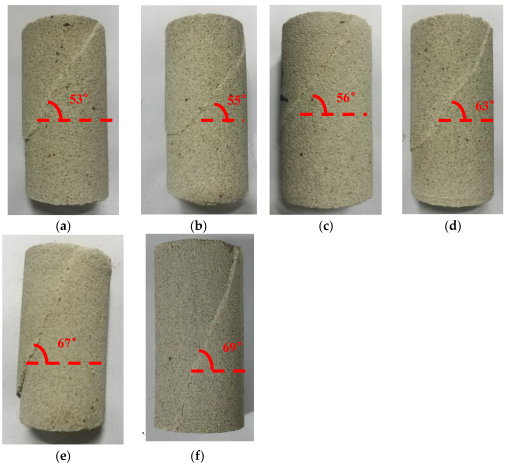
Disclaimer/Publisher’s Note: The statements, opinions and data contained in all publications are solely those of the individual author(s) and contributor(s) and not of MDPI and/or the editor(s). MDPI and/or the editor(s) disclaim responsibility for any injury to people or property resulting from any ideas, methods, instructions or products referred to in the content. |
© 2023 by the authors. Licensee MDPI, Basel, Switzerland. This article is an open access article distributed under the terms and conditions of the Creative Commons Attribution (CC BY) license (https://creativecommons.org/licenses/by/4.0/).
Share and Cite
Zhang, Y.; Zhao, Y.; Liu, Q.; Li, Y.; Lin, H. Energy Evolution Law of Sandstone Material during Post-Peak Cyclic Loading and Unloading under Hydraulic Coupling. Sustainability 2024, 16, 24. https://doi.org/10.3390/su16010024
Zhang Y, Zhao Y, Liu Q, Li Y, Lin H. Energy Evolution Law of Sandstone Material during Post-Peak Cyclic Loading and Unloading under Hydraulic Coupling. Sustainability. 2024; 16(1):24. https://doi.org/10.3390/su16010024
Chicago/Turabian StyleZhang, Yingjie, Yanlin Zhao, Qiang Liu, Yang Li, and Hang Lin. 2024. "Energy Evolution Law of Sandstone Material during Post-Peak Cyclic Loading and Unloading under Hydraulic Coupling" Sustainability 16, no. 1: 24. https://doi.org/10.3390/su16010024




